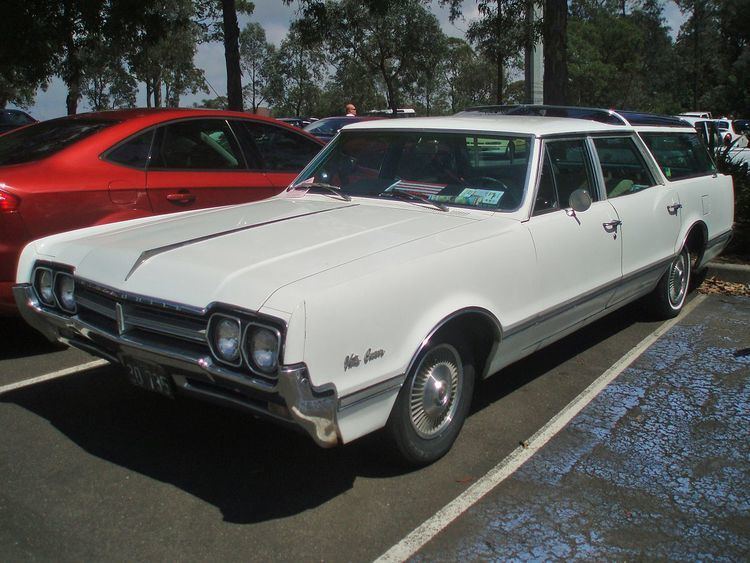Model years 1964–1977 Body style Station Wagon | Class Mid-size Layout FR layout | |
 | ||
Assembly | ||
The Vista Cruiser is a station wagon manufactured and marketed by Oldsmobile over three generations from 1964 to 1977.
Contents
The first and second generation Vista Cruisers are noted for their fixed-glass, roof-mounted skylights over the second-row seating with sun visors for the second row passengers, a raised roof behind the skylight and lateral glass panels over the rear cargo area along the raised roof — and three rows of forward-facing passenger seating.
Sharing its bodystyle with the Buick Sport Wagon, the Vista Cruiser was introduced on February 4, 1964, as a 1964 model, based on the Oldsmobile Cutlass/F-85 model. Prior to the 1973 model year the Vista Cruiser utilized a wheelbase which was 5 inches (127 mm) longer than that of the Cutlass/F-85 sedan.
Subsequent Oldsmobile mid-size wagons featured a skylight as did the 1991–92 full-size Oldsmobile Custom Cruiser wagon and the 1991–96 Buick Roadmaster wagon.
Reminiscent of earlier models, the third generation Vista Cruiser (1973–1977) featured optional rear-facing third row seating, while incorporating a single flat venting moonroof over the front row seating.
GM's 1971–76 full-size clamshell wagons, including the Oldsmobile Custom Cruiser, incorporated an optional forward-facing third row and a slightly elevated roof over the cargo area, though no skylight.
First generation (1964–1967)
The first-generation Vista Cruiser pioneered a raised roof with split skylight that began over the second-row seating, with lateral glass panels over the rear cargo area. Sun visors for second row passengers, with a third row of forward-facing passenger seating available as an option.
In 1964, the Vista Cruiser was one of three station wagons offered by Oldsmobile, the others being the F-85 built on the same wheelbase as other F-85/Cutlass intermediates and the full-sized Dynamic 88 Fiesta.
From 1965 to 1970 Oldsmobile dropped the full-sized 88 wagon, making the Vista Cruiser the division's largest; the shorter-wheelbase F-85/Cutlass wagon remained the entry-level offering.
Engines in the Vista Cruiser paralleled other Olds intermediates, with a 330-cubic-inch (5,408 cc) V8 offered from 1964 to 1967 producing from 210 to 320 horsepower (160 to 240 kW) depending on year and carburetion.
Transmission included the two-speed Jetaway automatic transmission and two rarely equipped manual transmissions, a three-speed column shift and a four-speed floor shift.
Second generation (1968–1972)
A major restyling of the GM A-body car line for 1968 replaced the split skylight with a one-piece unit, and stretched the wheelbase 1" to 121 in (3,073 mm).
From 1968 to 1972, a 350-cubic-inch (5,700 cc; 5.7 L) V8 became standard, with a high-output 400-cubic-inch (6,600 cc; 6.6 L) V8 from the 442 muscle car optional in 1968-69, and a 455-cubic-inch (7,460 cc; 7.46 L) V8 available from 1970 to 1972.
Transmission offerings through the years included one of two automatics—the two-speed Jetaway (1968) or three-speed Turbo Hydramatic (1968–72), or very rarely, a standard three-speed manual with column shift or optional four-speed manual with floor-mounted Hurst shifter.
In 1969, the "Dual-Action" tailgate was introduced as an option on two-row models and standard equipment on three-row.
In 1970, an exterior redesign sharpened edges and curves. Although it closely resembled the 1968-69 models, and is essentially regarded a second-generation car (The GM Skywagon Club recognizes the 1970-72 models as "Generation 2a"), many body parts were no longer interchangeable. The dashboard was also completely redesigned.
For 1971, Oldsmobile brought back the Custom Cruiser wagon on the full-sized 98 C-body chassis, featuring GM's disappearing clamshell tailgate, but the glass-roofed Vista Cruiser continued until 1972.
A small number of 1972 Vista Cruisers were modified by Hurst Performance for support car duties at the 1972 Indianapolis 500, joining the 1972 Hurst/Olds official pace car. Both were equipped with 455-cubic-inch (7,460 cc; 7.46 L) Rocket V8. Two modified Vista Cruisers are known to survive as of 2012, a press car and a medical director's car. As of 2012, the medical director's car is owned by a relative of Ray Harroun, the winner of the first Indianapolis 500 in 1911.
Third generation (1973–1977}
For 1973, the GM A-body intermediate platform was completely redesigned and the separate wheelbase used by the Vista Cruiser and Buick Sport Wagon eliminated; all A-body wagons were now built on the 116-inch sedan wheelbase. While its Buick counterpart was discontinued, the Vista Cruiser was redesigned as a woodgrained version of the new Cutlass Supreme station wagon. Despite the shortened wheelbase, three-row seating returned, with the third row facing rearward.
The model's distinctive skylights gave way to "Colonnade" styling, which partially offset the loss with frameless door glass that increased side window area. A pop-up sunroof over the front seats was optional.
A 350 cubic-inch Rocket V8 was standard, with a 455 cubic-inch Rocket V8 optional through 1976, replaced the following year by a 403 cubic-inch Rocket V8. The three-speed Turbo Hydra-matic transmission, power steering and power front disc brakes were standard equipment on Vista Cruisers from 1973-77.
